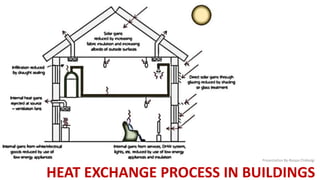
HEAT EXCHANGE IN BUILDINGS
- 1. HEAT EXCHANGE PROCESS IN BUILDINGS Presentation By-Roopa Chikkalgi 1
- 2. Thermal performance of the Building elements Heat exchange process in buildings The focus study is on the understanding of thermal quantities like –Heat –Heat flow –Conductance & resistance –Sol air temperature –Solar gain factor Presentation By-Roopa Chikkalgi 2
- 3. Temperature is actually not a physical quantity but it can be thought of as a symptom-as the outward appearance of the thermal state of a body. If energy is conveyed to a body, the molecular movement within that body is increased and it appears to be warmer. •Outward appearance of the thermal state of the body‐A symptom rather than a physical quantity. (Unit: degC or degree Celsius) •Degree of hotness of a body. –If day time temperature: 36 degC Night time temp. is 12 degC Diurnal range is 24 degC Presentation By-Roopa Chikkalgi 3
- 4. Heat is a form of energy, associated with the motion of atoms or molecules and is capable of being transmitted through solid and fluid media by conduction, through fluid media by convection and through empty spaces by radiation. As such, it is measured in general energy units: joules (J). Presentation By-Roopa Chikkalgi 4
- 5. Heat flow- Heat energy tends to distribute itself evenly until a perfectly diffused uniform thermal field is achieved. It tends to flow from high temperature to lower temperature zones, by any or all of the following ways: • Conduction • Convection • Radiation The 'motive force' of heat flow in any of these forms is the temperature difference between the two zones or areas considered. The greater the temperature difference, the faster the rate of heat flow. The rate of heat flow is measured in Watts (W). In most practical applications, the multiple of watt 'kilowatt' (kW), will be used. (1 kW = 1000 W) Presentation By-Roopa Chikkalgi 5
- 7. Convection In convection, heat is transferred by the bodily movement of a carrying medium, usually a gas or a liquid. The rate of heat transfer in convection depends on three factors: temperature difference (difference in temperature of the medium at the warmer and cooler points) the rate of movement of the carrying medium in terms of kg/s or m3/s the specific heat of the carrying medium in J/kg degC or J/m3 degC These quantities will be used in ventilation heat loss or cooling calculations. Presentation By-Roopa Chikkalgi 7
- 8. Radiation In radiation heat transfer, the rate of heat flow depends on the temperatures of the emitting and receiving surfaces and on certain qualities of these surfaces: the emittance and absorbance. Radiation received by a surface can be partly absorbed and partly reflected: the proportion of these two components is expressed by the coefficients absorbance (a) and reflectance (r). The sum of these two coefficients is always one: a + r = 1 Light colored, smooth and shiny surfaces tend to have a higher reflectance. For the perfect reflective theoretical white surface: r = 1, a = O. The perfect absorber, the theoretical 'black body', would have the coefficients: r = 0, a = 1. Presentation By-Roopa Chikkalgi 8
- 12. Sol-air temperature For building design purposes, it is useful to combine the heating effect of radiation incident on a building with the effect of warm air. This can be done by using the sol-air temperature concept. Ts = To + [(l x a)/fo] where Ts = sol-air temperature in ˚C To = outside air temperature in ˚C l = radiation intensity in W/m² a = absorbance of the surface fo = surface conductance (outside), W/m2 degC. Presentation By-Roopa Chikkalgi 12
- 13. solar gain factor (θ) The solar gain factor is defined as the heat flow rate through the construction due to solar radiation, expressed as a fraction of the incident solar radiation. Its value should not exceed 0.04 in warm- humid climates or 0.03 in the hot-dry season of composite climates, when ventilation is reduced. Presentation By-Roopa Chikkalgi 13
- 14. Heat exchange process in buildings Just like the human body, the building can also be considered as a defined unit and its heat exchange processes with the out-door environment can be examined. The thermal balance, i.e. the existing thermal condition is maintained if: Qi + Qs ± Qc ± Qv ± Qm - Qe = 0 Qi -Heat output from human bodies, lamps motors and appliances. Qs -The effects of solar radiations on opaque surfaces(but through transparent surfaces window can be considered separately) can be included. Qc -Conduction of wall may occur through the walls either inwards or outwards and is denoted by Qc Qv - Heat exchange in either direction may take place with the movement of air i.e ventilation. Qm - There may be introduction or removal of heat (heating or cooling) using some form of outside energy supply. The heat flow of such mechanical controls may be denoted as Qm Qe - If evaporation takes place on the surface of the building (eg roof pool) or within the building (human sweat or water in fountain) and vapors are removed, it produces a cooling effect. Presentation By-Roopa Chikkalgi 14
- 15. The existing thermal condition is maintained is cooling if: Qi + Qs ± Qc ± Qv ± Qm - Qe = Negative the existing thermal condition is maintained is hot if: Qi + Qs ± Qc ± Qv ± Qm - Qe = Positive Presentation By-Roopa Chikkalgi 15
- 16. The thermal performance of a building depends on a large number of factors. They can be summarised as (i) design variables (geometrical dimensions of building elements such as walls, roof and windows, orientation, shading devices, etc.); (ii) material properties (density, specific heat, thermal conductivity, transmissivity, etc.); (iii) weather data (solar radiation, ambient temperature, wind speed, humidity, etc.); and (iv) a building’s usage data (internal gains due to occupants, lighting and equipment, air exchanges, etc.). Presentation By-Roopa Chikkalgi 16
